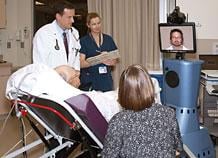January 23, 2014 — Research published in the
American Journal of Managed Care indicated using
telemedicine to deliver
stroke care, or telestroke, appears to be cost-effective for society.
Telestroke robots allow stroke patients in facilities with no neurology specialists to receive real-time consultation from neurologists in other areas via computer.
"This study shows that a hub-and-spoke telestroke network is not only cost-effective from the societal perspective, but it's cost-saving,” said neurologist Bart Demaerschalk, M.D., director of the Mayo Clinic Telestroke Program, and the lead investigator of the telestroke cost effectiveness
study. “We can assess medical services, like telemedicine, in terms of the net costs to society for each year of life gained."
The study estimates a telestroke system consisting of a single hub and seven spoke hospitals may result in the appropriate use of more clot-busting drugs and
catheter-based interventional procedures, with more stroke patients discharged home independently. Despite upfront and maintenance expenses, the entire network of hospitals may realize a total cost savings.
When comparing a rurally located patient receiving routine stroke care at a community hospital, a patient treated in the context of a telestroke network incurred $1,436 lower costs and gained 0.02 quality-adjusted life-years over a lifetime.
Benefits of telestroke include reduced resource use for services such as inpatient rehabilitation, nursing homes and caregiver time.
The study was conducted by researchers at Mayo Clinic, Georgia Health Sciences University, Analysis Group.
Mayo Clinic in Arizona serves as the hub in a network of 13 spoke centers. More than 4,000 emergency consultations between Mayo stroke neurologists and physicians at spoke centers have taken place since the telestroke program began. Mayo Clinic Telestroke has hubs in Arizona, Florida and Minnesota, and serves more than 20 healthcare institutions in seven states.
For more information: www.mayoclinic.org


